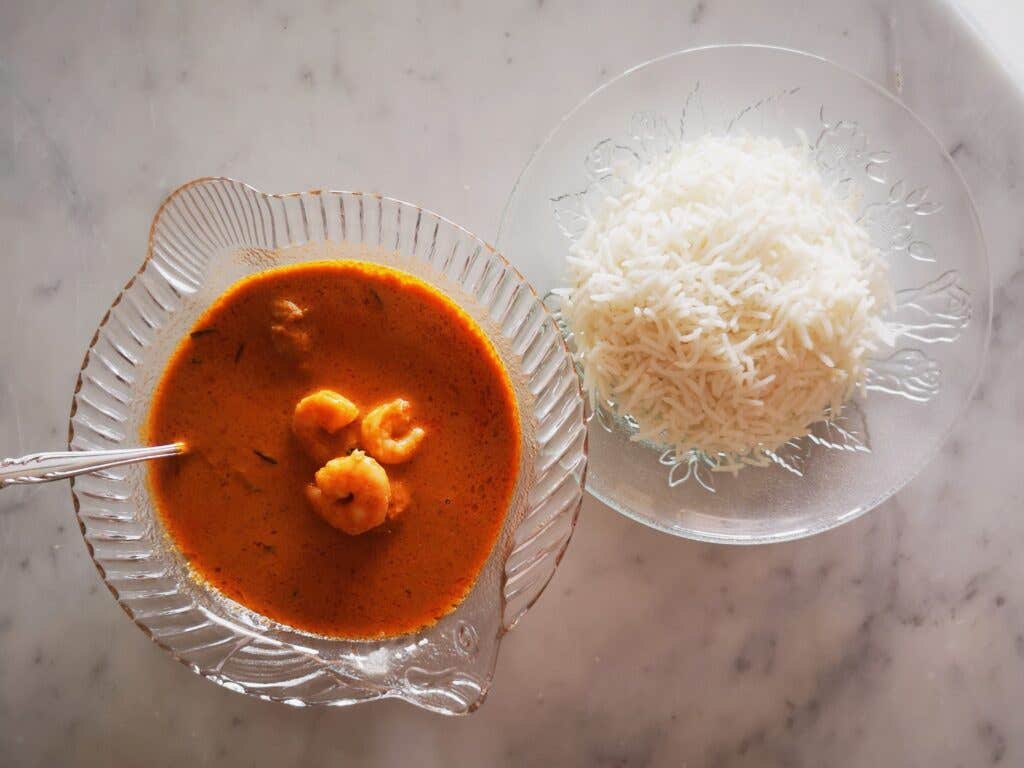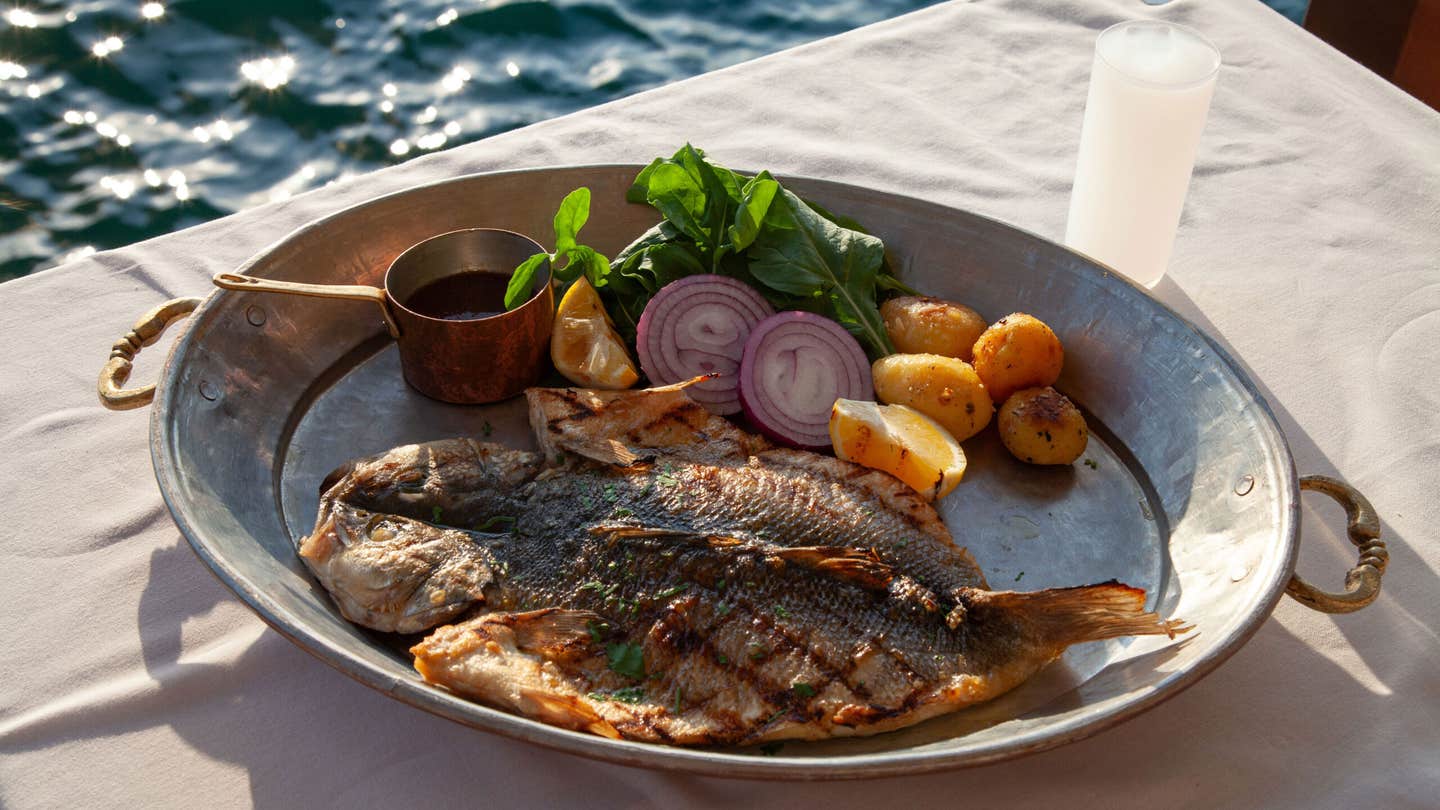
Indian Curry is Largely “Unmappable”—But This Writer Found Her Way Home Through One Recipe
Her mother’s Parsi-style, seafood-studded stew.
When I came back to sun-brightened Mumbai after getting a degree in London, I had never felt so far from myself. The road ahead felt bouldered, the path itself lost to me.
Then, as always, it was to food that I turned for reorientation. My mother, in a fluster of anxiety, poured out a flurry of dishes—all the Mumbai chaat that I had missed terribly, the chile cheese toast, the potato bhajias. But most satisfying was the stream of rainbowed curries. Best of all was her red seafood curry, made Parsi style the way her mum made it, the colour of a flame-charred sunset in winter, its apricity seeping into my bones.
More than anything, I loved to watch my mum make it. The scrunch of the knife as it pressed down on an onion, the smell of frying coconut tendrilling through the air, the slick of oil bubbling up around the red chile masala, the burble of the coconut milk as it roiled in the pan—it all brought me back to myself. I no longer felt like I was living my life behind frosted glass. And although it wasn't quite the cresting of the hill that I had expected, it was certainly the start of it.
What’s in a Name?
The word “curry” is sometimes used in the West as a familiar semaphore, but the term ossifies the immense sophistication and complexity of Indian food. K.T. Achaya’s explanation for the English usurpation of curry has been the one largely memorialized in public discourse: “The meat dishes cooked with pepper were called kari in Tamil, a word now used in English as curry,” he writes in his seminal The Story of Our Food.
But it is possible the word reaches beyond the English, perhaps to the Portuguese. Gaspar Correa, travelling with Vasco da Gama, used the word “caril” in 1503, and in 1623, so did Pietro del Valle, who scurried up and down India’s western coast: “Caril is a name which in India they give to certain Broths made with Butter, the Pulp of Indian Nuts, (instead of which, in our Countries Almond Milk may be us'd, being equally good, and of the same virtue) and all sorts of Spices, particularly, Cardamoms and Ginger, (which we use but little) besides herbs, fruits, and a thousand other condiments,” he wrote in The Travels of Peter Della Valle, Sirnamed The Traveller. (Italics and capitalization his.)
Whatever its past, in India today, curry refers to a very specific type of dish, with protein or vegetables sunk in a pool of spiced gravy, halfway between a stew and a soup; fractals of rich, layered creations shored up by a constellation of thickening, spicing, coloring, and souring agents, and eaten with rice, flatbreads, or leavened breads. It isn’t a catch-all phrase for all Indian food by any means. “A curry recipe will be better understood if we work out the role that each ingredient plays in the recipe. The effect of each of the spices is a little complex,” writes Camellia Panjabi in The Great Curries of India.
The ingredients of each hew to the geography of its home state. For instance, the Pandi (pork) curry of the Kodava community of Karnataka gains its flavor from the connivance of peppercorns and kachumpuli, a strident, ink-dark vinegar drawn from the panapuli (aka kodampuli) fruit tree that capillaries through the state. Similarly, the western coast of India is furred with palm trees; as a result, many of its gravies are anchored in ground or milked coconut.
Even within the western coast, there are differences in ingredients. Mum's burnished Parsi curry, unlike its coastal kin, is girded by khuskhus (poppy seeds) and besan (gram flour), its sourness coaxed from tomatoes and tamarind rather than the more popular kokum fruit. Cashews pounded into an oleaginous paste add a creaminess that slakes the scald of the chiles. And the curry is always served with a slash of lime and kachumber: stripes of onions, cucumber, and tomato jounced with vinegar and salt and scalpel-sharp green chile.

Aside from this red curry, the Parsi community makes plenty of others: a green coriander curry with green chile chiming through it like a bell; a hazel-yellow curry with an undertow of peanuts and poppy seeds; a decadent sau badam ni curry (curry of 100 almonds); and the rare and completely absurd cutlace ni curry, made with breaded meat cutlets that likely came about to bare the kitchen of leftovers.
All of these curries, much like Parsi cuisine, are magpie dishes plundered from here and there; their ingredients reading like pages scythed from the history books of the community. Parsis were religious refugees from Iran who settled on India’s western coast a millennium ago. The use of cashews and almonds and peanuts finds its roots in Iran's abundance of nuts and dried fruit. Our dislocated love for Iran’s freshwater fish was soon resurrected in the seafood of India's western coast. Also from the coast came coconut, rather exuberantly fuelling most of our curries. And then there is the near omnipresence of tomatoes and chile, once-foreign ingredients transhipped to India by the Portuguese and now pinned into the pantheon of Indian cuisine.
Although most conversations about Parsi food are marooned within euphoric descriptions of dhansak, a mutton or chicken stew eaten with caramelized brown rice and the best-known dish of the community, many Parsi restaurants also list curry on the menu. In fact, “the seafood curries have always been the best-selling items on the menu,” says Kainaz Contractor who runs Rustom's in Delhi with her partner Rahul Dua. (They recently replaced their red seafood curry with the yellow kind). Jimmy Boy, a popular restaurant in Mumbai, makes five curries: egg, mutton, chicken, prawn, and fish versions.
“The secret of making a good curry again lies in the slicing and frying of the onions and masala,” writes Bhicoo Manekshaw in Parsi Food and Customs. “The masala should be finely ground...the curry should not be allowed to boil. It should be simmered with the lid half covering the pan and should be cooked at least two to three hours before serving, so that all the different flavours are amalgamated and brought out just right. Finally, a good curry needs a good rice which should be steamed or boiled.”
It is always hard to coax exacting recipes from my mother; they live under her skin and she draws them out subconsciously onto the plate. Nevertheless, here are some more words of advice wheedled from her while she cooks: “Chop the onions into fine flakes and fry them in more oil than you think you need, on gentle heat. Stir, stir, stir often or else they will gum themselves to the pan; when they shift from glossy pink to amber is how you know they are ready. The tomatoes, you grate.”
An additional tip: Buy prawns still cloaked in their carapace. Prawn heads are particularly delicious. In a large oiled pan, fry the shells until the pieces burnish to pink, then bruise the shells with the back of a heavy spoon until they fissure. Add two cupfuls of water next, slowly simmering until the stock lowers to half. Then layer malmal (or any diaphanous cloth, such as cheesecloth) over a finely-veined sieve, and mash through as much of this essence of prawn as you can. This elixir is what you pour into your curry paste for an infusion of umami. It will lift your curry beyond all others.
Further urgings from my mother: each curry is largely unmappable, she believes, so her advice is to be merely used as waymarkers on your trail to the perfect curry. Take your bearings from her, as I did, then let them guide you safely home.
Keep Reading
Continue to Next Story










